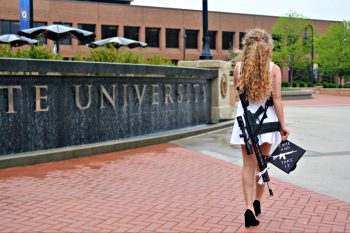We are developing the social individualist meta-context for the future. From the very serious to the extremely frivolous... lets see what is on the mind of the Samizdata people.
Samizdata, derived from Samizdat /n. - a system of clandestine publication of banned literature in the USSR [Russ.,= self-publishing house]
|
I give you Kaitlin Bennett from Ohio, as reported by BBC News:

As a woman, I refuse to be a victim & the second amendment ensures that I don’t have to be.
.@KentState puts up fliers in dorms w/ the stat that 1 in 4 women will be sexually assaulted in college, but denies women the right to protect themselves with their firearm. In 2016 KSU reported 3x as many rapes on campus than 2015. Stop letting women be victims. #CampusCarryNow
The 2nd amendment isn’t about hunting deer. It’s about being able to protect yourself from an out of control, tyrannical government.
“Armed gang pick on the wrong gran as she fires CROSSBOW at masked men who kicked down her door”, reports the Daily Mirror.
A woman has told how she shot at a machete-wielding intruder with a CROSSBOW when a gang burst into her home and attacked her family.
Anji Rhys, 49, said she sprang into action when masked raiders kicked down her door in Dunstable, Bedfordshire, after apparently mistaking it for a drugs den.
Ex-Thai boxer Anji, who is reportedly a grandmother, grabbed her crossbow, which she dubs Manstopper, and shot one thug during the horrifying ordeal.
Anji keeps the bow on a wall inside the house to protect her family which include her partner Rebecca, son Dillon and elderly mum Lilian.
The so-called survivalist, who possesses an arsenal of weapons inside her home, was reportedly watching TV when the yobs entered her home and pinned down her son.
Don’t get me wrong, I am happy to read that this lady was able to protect herself and her family. But I am mystified by the supportive tone of the Mirror reporter, and of most of the comments, when exactly the same sequence of events but involving a gun-wielding grandma in the US instead of a crossbow-wielding one in the UK would have been dismissed as NRA propaganda and further evidence of the lunacy and barbarism of Americans in their “love affair with the gun”.
A 78-year-old man was arrested after he stabbed a burglar in his house. He was arrested on suspicion of grievous bodily harm. The burglar died and the man was then arrested on suspicion of murder. Later he was released on bail.
I can not find much to disagree with in Godfrey Bloom‘s assessment of the matter (though I know little of his views on other subjects), nor Karren Brady writing in The Sun (though I don’t agree with other things she has written there).
This exchange on Guido’s site sums up most of the possible arguments about this:
Happy Day (quoting Godfrey Bloom): What other country in the world would have arrested a 78 year old pensioner for defending his wife and defending his house in the middle of the night?
Greenacres: A civilized one. A man died, Police did a cursory investigation and released the suspect without charge at the earliest opportunity. The outcome is a tragedy for the pensioner and i’d do exactly the same as him if the situation was reversed but the circumstances of any death have to be investigated.
thinktheunthinkableuk: Investigate…yes. Question him……….yes. Get a statement…..yes. But was there any need to “arrest” him? Or lead him away in handcuffs? Or detain him in police custody for 2 days?
I would extend extreme benefit of the doubt to anyone in this situation. As Brady writes, he should have been “offered a cup of tea and a comforting arm around his shoulders” above all else. I think it should be possible to determine what happened in this sort of situation without arresting anyone.
The report on this incident in the Metro lists three other cases that may be worth further study.
Despite the fact that I foresaw all this years ago. So did you. So did anyone with the slightest knowledge of the principles of law. So did anyone who had ever read a fricking detective novel.
The Times reports,
Metropolitan Police ditches practice of believing all victims
Britain’s biggest police force has abandoned its policy of automatically believing victims after a series of flawed inquiries into alleged sex crimes, The Times can reveal.
Cressida Dick, the Metropolitan Police commissioner, said she had told officers they must have an open mind when an allegation is made and that their role was to investigate, not blindly believe.
“You start with a completely open mind, absolutely,” she said. “It is very important to victims to feel that they are going to be believed. Our default position is we are, of course, likely to believe you but we are investigators and we have to investigate.”
The issue has become one of the most fraught for the police service since a national policy instructed officers to believe alleged victims automatically. It was aimed at encouraging people to come forward with the confidence that they would be taken seriously, particularly in sexual abuse cases.
The guidelines were put in place after revelations in 2011 that police had failed to properly investigate abuse allegations, including by victims of the former BBC presenter Jimmy Savile, who was revealed after his death to have been Britain’s most prolific paedophile. However, the Met was later severely criticised after its detectives placed their faith in a man known only as Nick, declaring that his uncorroborated claims of a Westminster abuse ring were “credible and true”. The Crown Prosecution Service is considering whether Nick will be charged with perverting the course of justice after his claims were shown to be false.
Sir Richard Henriques, a retired judge, identified failings in Operation Midland and said that the instruction to believe a victim’s account should be withdrawn. It undermined the principle of suspects being innocent until proven guilty, he said in 2016.
Ms Dick took the helm at Scotland Yard nearly a year ago, after the collapse of Operation Midland. Asked if she was rethinking the belief policy, she said: “Rethink? I’ve rethought. I arrived saying very clearly to my people that we should have an open mind, of course, when a person walks in. We should treat them with dignity and respect and we should listen to them. We should record what they say. From that moment on we are investigators.”
She said that the police had been criticised for not being open-minded enough. It was important to encourage victims to come forward and she wanted to “go on raising confidence”.
She said: “Our job in respect of investigations is to be fair, to be impartial, and where appropriate to bring things to justice — and of course to support victims, but it isn’t all about victims.”
That is progress. But I note that she is still saying “victims” instead of “those who claim to be victims”.
The basic facts are given in this Wikipedia page: Poisoning of Sergei and Yulia Skripal, and there is a BBC “What we know so far” piece here. I keep hoping to read somewhere that they are beginning to recover. I keep not doing it.
What should the UK government do? What do you think about the measures it has taken so far?
Here are some opinions from several different points of view to get you started:
What can Theresa May do about Russia over the Salisbury poisoning? – Dominic Waghorn, Sky TV.
After the Skripal attack, talk of war only plays into Vladimir Putin’s hands – Simon Jenkins in the Guardian.
Alex Salmond: Don’t shut down my TV show over spy attack – Andy McLaren, STV News.
What’s interesting about this Florida school shooting is that events are revealing themselves in such a way that not even the most statist of gun controlling media types are able to spin the narrative to their ends. The old adage that “when seconds count, the police are only minutes away”… well, that’s a pithy line, and it hits home. It also assumes that the police are minutes away. Not in this case. In fact, the police were seconds away, yet they didn’t intervene. In Parkland, it wasn’t that the state couldn’t protect you – no, it could have. Actually, the state wouldn’t protect you. You were on your own.
What message should the ordinary citizen take away from this? That it is clear and painfully obvious they need to protect themselves.
Best justification for the 2nd Amendment in my lifetime at least.
– James Waterton
Like Matt Walsh, I remain baffled at why the slaughter of concert-goers in Las Vegas a few months ago, and the almost total lack of evidence or data on the killer’s motives and actions, haven’t caused much in the way of a media/political firestorm, contrasting with events of recent days:
If you recall, dozens upon dozens of people were gunned down in Las Vegas on October 1. There were 58 fatalities in total. Another 422 injuries. That’s 480 casualties — 480 casualties — and I’m not even counting the hundreds more injured by trampling or shrapnel. It was the worst mass shooting in modern American history by a mile. It had more casualties than Orlando, Virginia Tech, Sandy Hook, and Parkland combined — times two. And it was carried out in the middle of a major American city.
Yet that terrible massacre seemed to fade from the headlines rapidly and inexplicably. The country had almost entirely moved on by the beginning of the following week. It seemed to me that we had forgotten about it within three or four days, but I’ll say a week just to be safe. The media is so obsessed with Parkland that several of its survivors are now practically household names. Does anyone remember the names of a single one of the Las Vegas survivors? Did any of them do media tours? Did CNN hold a “town hall” about Las Vegas? Was there an extensive conversation about potential law enforcement failures in Las Vegas, as there has been about their failures in Florida? We’ve all had quite a bit to say about the police officer who waited outside while kids were gunned down, but what about the police officers and armed security who made it to the shooter’s hotel room while he was still raining shots down on the crowd, but stood outside the door for an hour before entering?
From my vantage point, it seems that fairly early on, the media seemed to give up a hunt for explanations and for holding various people to account. Consider this point: Vegas hotels are famously packed with CCTV to foil thieves and crooks of various descriptions. And yet a man was able to get a large cache of weapons into a room and do what he did.
The trouble with even writing about this topic now is that I feel that I sound like a conspiracy nut, which I am emphatically not.
All very odd.
“Moreover, an assault-weapon ban (along with a ban on high-capacity magazines) would gut the concept of an armed citizenry as a final, emergency bulwark against tyranny. No credible person doubts that the combination of a reliable semiautomatic rifle and a large-capacity magazine is far more potent than a revolver, bolt-action rifle, or pump-action shotgun. A free citizen armed with an assault rifle is more formidable than a free citizen armed only with a pistol. A population armed with assault rifles is more formidable than a population armed with less lethal weapons. The argument is not that a collection of random citizens should be able to go head-to-head with the Third Cavalry Regiment. That’s absurd. Nor is the argument that citizens should possess weapons “in common use” in the military. Rather, for the Second Amendment to remain a meaningful check on state power, citizens must be able to possess the kinds and categories of weapons that can at least deter state overreach, that would make true authoritarianism too costly to attempt.”
– David French, at National Review.
Sorry for the unoriginal choice of title. This is about the fourth Samizdata post with a title related to that slogan, and the umpteenth to mention it. Don’t blame us. If the authorities would stop repeatedly proving that slogan to be a cruel travesty, we would be happy to stop going on about it.
Until that day arrives, the Guardian has a good report on the latest example of what innocent people have to fear:
Police made ‘appalling’ errors in using internet data to target suspects
Police have made serious errors getting search warrants for suspected sex offenders, leading to the targeting of innocent people and children being wrongly separated from their parents, an official report has revealed.
The errors – highlighted by the interception of communications commissioner, Sir Stanley Burnton, in his annual report to the prime minister – had “appalling” consequences and related to some of the most intrusive powers the state can use against its citizens.
In one example, two children were separated from their parents for a weekend while the parents were questioned as suspects in a child sexual exploitation case. It later emerged that police had raided the wrong address due to an error on the documentation and the parents were innocent.
Digital devices belonging to innocent people were also forensically examined by police, Burnton said.
The errors identified were mainly because details were wrongly entered into software that helps police work out the location where a specific IP (internet protocol) address has been used.
But IP addresses are routinely reassigned by internet providers. Burnton warned investigators not to rely on them when trying to work out who is hiding behind the anonymity of the internet to commit crimes.
He wrote: “These [errors] are far more common than is acceptable, especially in cases relating to child sex exploitation. The impact on some victims of these errors has been appalling.”
An interesting, and to my mind convincing, posting by Eric Raymond:
Decentralized threats are the mother of liberty because the optimum adaptive response to them is localist and individualist – the American ideal of the armed citizen delegating power upward. Centralized threats are the father of tyranny because the optimum response to them is the field army and the central command – war is the health of the state.
There is an implication for today’s conditions. Terrorism and asymmetrical warfare are decentralized threats. The brave men and women of Flight 93, who prevented September 11 2001 from being an even darker day than it was, were heroes in the best American tradition of bottom-up decentralized response. History will regret that they were not armed, and should record as a crime against their humanity that they were forbidden from it.
He links to this essay by Dave Kopel.
A book comparing and contrasting UK and US experiences with guns, by Joyce Lee Malcolm, is also worth reading. Here is her website.
What are Cambridgeshire police for?
“Police find stolen caravan hunt too risky”, reports the Times:
An owner was forced to retrieve her stolen caravan from a traveller site after police refused to enter, claiming that it was unsafe.
Officers from Cambridgeshire police were called by Helen Cox, 44, after her family caravan was taken from a farm near her home in Ely.
The force told her that they had spent five hours trying to gain access to the site, in which the caravan had been spotted by a local farmer, but that the travellers “wouldn’t let them in”.
Instead, Mrs Cox’s mother arranged for a microlight to fly overhead and capture images of the caravan hidden by some trees. She gave the photographs to police but officers still refused to enter, claiming that they had too little information to obtain a warrant.
In the end, Mrs Cox launched a social media campaign to try to retrieve her property. Several people said that they had seen the £9,000 Hobby Excellent caravan, and shortly afterwards it was found dumped in a nearby field. Mrs Cox said that a dozen travellers had surrounded her when she went to collect it.
The same story was reported in the Mirror:
“Woman tracks down her stolen £9,000 caravan to travellers’ site using microlight after police ‘too scared’ to enter camp”
…She [Ms Cox] added: “I had posted the stolen caravan all over Facebook and that is why I have it back.
“In the words of the PCSO who accompanied us to the caravan, ‘I’ve never seen a caravan returned to its owner in x number of years’.”
A Cambridgeshire Police spokesman said: ‘Officers attended the location of where it was believed the stolen caravan was and also used a drone to look over the site, however these attempts were unsuccessful.
“Due to officer safety it was not safe or legal for them to enter the site.
“There was insufficient information for officers to be able to obtain a warrant to access the site, however the caravan has since been recovered and returned to its owners.”
A masterful use of the passive voice there. “Has since been recovered and returned to its owners.” A reader who did not know the whole story might even think Cambridgeshire Constabulary had something to do with it.
I won’t add an extract from the Daily Mail story (“Caravan owner is forced to track down her stolen £9,000 vehicle to a travellers’ site with a MICROLIGHT after police refuse to send officers fearing for their safety”), as it is almost identical to that of the Mirror and very similar to that of the Times. (Despite the demonization of the Mail as “fake news”, this similarity is not uncommon.) Both the tabloid newspapers quote a comment on social media from Larry Locke, who said, “I would like to know what we are paying the police for […] if that had been in my house they would soon be in, even if I said you could not come in. Is there a law for one and not for another?”
That bewildered question has been heard in this context for a while now. Back in 2011 in a post called “Guardian readers hate gypsies and travellers”, I wrote, “If you want to poison a human soul with racial hatred, just do that. Tell him that the laws that burden him do not apply to them.”
|
Who Are We? The Samizdata people are a bunch of sinister and heavily armed globalist illuminati who seek to infect the entire world with the values of personal liberty and several property. Amongst our many crimes is a sense of humour and the intermittent use of British spelling.
We are also a varied group made up of social individualists, classical liberals, whigs, libertarians, extropians, futurists, ‘Porcupines’, Karl Popper fetishists, recovering neo-conservatives, crazed Ayn Rand worshipers, over-caffeinated Virginia Postrel devotees, witty Frédéric Bastiat wannabes, cypherpunks, minarchists, kritarchists and wild-eyed anarcho-capitalists from Britain, North America, Australia and Europe.
|




